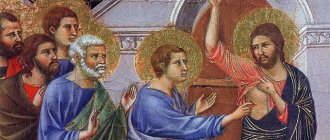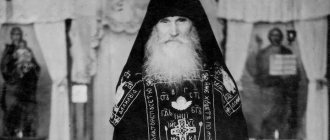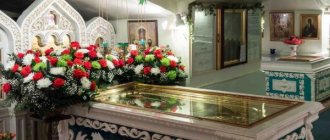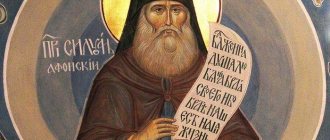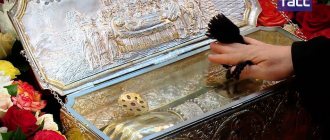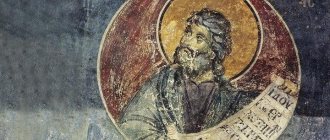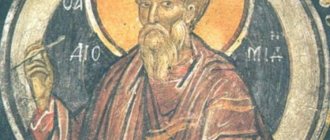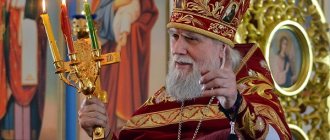Biography of Saint Herman of Alaska
For a long time there was no reliable information about the life of the saint before he entered the path of serving the Lord (until 2003). A spiritual feat in the name of the faith of Christ was described 30 years after the death of Herman of Alaska.
Origin and childhood of Herman of Alaska
Herman was from a peasant background (according to information from the Central Historical Archive). The dates of birth differ by several years: 1751/1755/1756/1757. Place of birth - Voronezh province, modern city of Serpukhov. Worldly name - Egor Popov.
Military service
At the age of 17, the young man’s lot fell to become a soldier. Wanting to evade the army, he hid in the Sarov Monastery. But the recruits found Yegor Popov and assigned him to serve in the office of the military district (voivodeship). Ten years later, the military districts were reorganized. Those who did not want to continue serving were allowed to go to the monastery.
Monastic tonsure
Yegor Popov became a novice at the Sarov Monastery. His spiritual mentor was Hieromonk Nazariy. When Nazarius was transferred to the St. Petersburg diocese in 1782, and then to Valaam, Popov followed him. In the Valaam monastery, Yegor took monastic vows under the name Herman.
Egor experienced the mercy of the Mother of God himself as a novice. A tumor began to grow in his throat, disfiguring his face and causing excruciating pain. Yegor began to pray fervently in front of the icon of the Mother of God. Before the prayer service, Yegor wiped the icon with a wet towel and then tied it around the sore spot.
The prayer vigil lasted all night. In the morning the novice fell asleep next to the icon. In a dream, he dreamed that the Mother of God healed him. Waking up, Yegor was happy to discover that instead of a tumor there was a small scar.
Solitude on the Karelian Islands
After 5 years of service in the Valaam monastery, Herman decided to become a hermit. Before retiring and continuing his ministry, Herman passed the tests assigned to him by Nazarius. With his blessing, the ascetic left the monastery, building himself a cell in the thicket of the forest, 2 kilometers from the monastery. Herman returned to the monastery on Orthodox holidays to take part in solemn services.
Alaskan Mission
The discovery and inclusion of new lands in the northeast into the Russian Empire raised the question of their development, including the spread of the Orthodox faith among the local population.
In 1793, Metropolitan Gabriel turned to the rector of the Valaam Monastery, Nazarius. He proposed selecting 10 people from among the Valaam monks for the First Spiritual Mission to the Aleutian Islands. Monk Herman was also among the chosen ones (at his own request). Archimandrite Joasaph was appointed head of the Mission.
Kodiak Island was chosen as the center of the Orthodox mission. Here in 1794 a temple was erected and a monastic monastery was established. Father Herman worked in a bakery and other household services. In 1799, Joasaph, along with 5 monks, died during a storm.
In 1804, the hieromonk of the Alexander Nevsky Lavra, Gideon, was sent as the head of the mission. After 3 years, he returned to Russia, entrusting responsibilities to Herman. By this time, the monk remained the only spiritual shepherd in Russian North America.
Before leaving, Gideon offered Herman introduction to the rank of hieromonk, then promoting him to the rank of archimandrite. But Herman refused elevation, remaining a monk until his last days.
Spruce Island
Reverend Herman, left alone, moved from Kodiak Island to Spruce Island, separated by a 2-kilometer strait. The uninhabited island was covered with forest, a small stream flowed from the central part into the ocean. In memory of the Valaam monastery, Herman named it New Valaam.
Here he dug himself a dugout. By winter he had a wooden cell. The monk planted a garden next to his home, where he grew vegetables. He distributed everything he grew to orphans and needy Aleuts. I prepared mushrooms for the winter and evaporated salt from seawater brine.
His attire was a kukhlyanka worn to the skin, an old cassock, a cassock, a hood, boots or shoes. In winter and summer he wore these clothes. He slept on a bench covered with old deerskin, with two bricks at the head. He covered himself with a board, which served as a blanket for him. The holy father wore 8-milligram chains on his body.
A chapel and a house for visitors and students were built next to the cell. Holy Father Herman taught Aleut children the Holy Scriptures and singing, baptized and married converts. On Orthodox holidays, he gathered Aleuts near the chapel.
The disciples read prayers, the elder read and explained the Gospel and the Acts of the Apostles. Fiery faith inspired the speech of Father Herman, which made an indelible impression on the listeners. People came to him for advice in everyday situations, including family conflicts.
The Aleuts suffered many insults from Russian merchants and could have rejected the Orthodox faith as the faith of exploiters. But the Monk Herman, with his way of life, participation in their problems, and spiritual conversations, inspired deep respect among the islanders, who saw in him a person different from the evil aliens.
The monk saw his duty and calling in protecting the local population, calling himself their servant and nanny. During the smallpox epidemic on Kodiak Island, Holy Father Herman visited the sick, trying to calm them down, make them humble themselves, and repent before death.
Every day the elder held prayer services in his cell before the icons of the Mother of God and Jesus Christ. When Russian colonists asked him if he was bored alone in the thicket, the saint answered that he was not alone, but with God, angels and saints.
Death of Father Herman
The saint's apostolic ministry continued until the end of 1837. The Lord revealed to him the date of his death. Father Herman predicted the day of his death to his spiritual children and left a covenant on how to bury them. On December 13, at his request, they lit candles in front of the icons and began to read the Acts of the Apostles. At this time he died.
“The mere thought of visiting Alaska captures the imagination of a person, especially a Russian. The reasons to visit the region discovered and developed by Russians may be different, but the excitement is always the same. It's huge. To anyone who does not believe my story, I want to sincerely and strongly advise - find the opportunity to visit there, and you will personally see that this is Russian land […] I think the main reason lies in the fact that this distant northern land was consecrated by Russian clergy , among whom was the Monk Herman, glorified in 1970 as Herman of Alaska.” This is a fragment of the article “Kodiak. Pilgrimage to Herman of Alaska,” written for the publication “Russian Messenger” (issued May 22, 2008). Its author is Alexander Dmitrievich Portnyagin, professor at Johnson and Wales University, (Providence, Rhode Island, USA).
The history of Russian America, which began with the achievement of the northwestern territories of the continent by the Bering-Chirikov expedition in 1741, goes back 126 years. In 1867, by decree of Sovereign Alexander II Nikolaevich, Alaska and the adjacent islands, which were part of the American colonies of the empire, were sold to the United States. However, despite the relatively short period of existence, Russian America has given domestic and world history many examples of true service to the Motherland. But now we are not talking about discoverers, researchers and industrialists, many of whom can rightfully be considered today “Russian heroes of Alaska” both in our country and in the USA. Spiritual and ascetic feats also took place in Russian America, and the educational acts of the clergy who were part of the first Orthodox mission sent to Alaska remain a legend in those places to this day. The most famous among them is the monk Herman (1757-1836).
Preacher in Russian America
“He endured everything, endured everything - the harsh nature, the harsh disposition of the first local rulers, the freedom of sailors, hunters and traders, monastic loneliness. The payment for everything was the sincere love of the “converted pagans” for him. Herman himself was the embodiment of philanthropy and willingness to help everyone; he himself knew how to do carpentry, fished, sawed wood, and baked bread for the Kodiak settlement. Herman lived here longer than any other Russian - forty-three years. Until the end of his days, the monk was the protector of the common people, both local and newcomers, - he treated, advised, gave whatever gifts he could, and set up a shelter for orphans.” This is what the famous journalist Vasily Mikhailovich Peskov wrote about Father German in his book of travel essays “Alaska is more than you think” (M.: Komsomolskaya Pravda, 1994). Peskov was the first Soviet journalist to get to these lands and remained fascinated by Alaska, its preserved Russian spirit, Russian history, and the elusive aroma of incense, which seems to have remained forever on the islands of what was once Russian America.
In the “Orthodox Encyclopedia”, edited by Patriarch Kirill of Moscow and All Rus', it is said about Herman (author’s note: with abbreviations explained): “For the first time, information about the life and veneration of Herman was published in the Valaam Monastery in 1868. In 1936, Archimandrite Gerasim (Schmaltz) opened the holy relics of the elder and placed them in a specially built small chapel. On August 9, 1970, on Kodiak Island in the Cathedral of the Resurrection of Christ, Metropolitan of All America and Canada Irenaeus (Bekish), concelebrated by a host of bishops, solemnly glorified Herman as an Equal-to-the-Apostles saint. The relics of Herman were placed in the cathedral in a wooden shrine, on which were placed the kamilavka and iron cross with a paraman that belonged to the saint. On the same day, August 9, 1970, Herman was glorified by the Russian Orthodox Church Abroad in the Cathedral in honor of the Icon of the Mother of God “Joy of All Who Sorrow” in San Francisco. By the determination of the Holy Synod of the Russian Orthodox Church on November 12, 1970, Herman’s name was included in the month book. He became the first Orthodox saint in America."
Old Valaam
So who is he, Saint Reverend Herman, the first Orthodox saint of the whole part of the world? Where are you from? How did you get to Valaam, and then to Russian America?
Here are excerpts from the report of Nikolai Semenovich Popov, a senior researcher at the Ryazan Museum of Travelers, made at the Round Table meeting “230th anniversary of the founding of the first Russian settlements in America and the 220th anniversary of the formation of Orthodoxy in America” at the Institute of General History of the Russian Academy of Sciences. (Moscow. November 26, 2014).
“The chief specialist of the department of ethnography of the peoples of America of the Museum of Anthropology and Ethnography named after Peter the Great, Sergei Anatolyevich Korsun, in 2003, in the Central State Historical Archive (St. Petersburg), discovered a number of documents, copies of which he provided to the Ryazan Museum of Travelers. In archival file No. 407 dated 10/12/1782: “According to the report of the synodal member of the Right Reverend Novgorod about the tonsure of those in the Spaso-Preobrazhensky Valaam Monastery,” Gabriel, Bishop of Novgorod, informs the Holy Governing Synod about the tonsure as a monk of the Valaam Monastery of the former sub-chancellor of the Kadoma Voivodeship Office Yegor Ivanov’s son Popov […] Later, Bishop Gabriel of Novgorod reported to the Synod that on November 1, 1782, Popov was tonsured and received the monastic name Herman.
Old Valaam in winter
From these documents it follows that Herman of Alaska before his tonsure bore the name Yegor Ivanovich Popov. By that time he was 31 years old. This means that E.I. Popov was born in 1751.
Question two: what did Yegor Ivanovich Popov do before becoming a Valaam monk? According to archival file No. 407 from the St. Petersburg Central State Historical Archive, Popov, until December 23, 1777, served as a sub-clerk (junior clerk, copyist of papers) in the voivodeship office of the city of Kadoma. […] Kadom, once a Ryazan city, from the beginning of the 18th century. managed to visit the Kazan, Azov, Voronezh, and then Tambov provinces. Only in Soviet times the city was returned to the Ryazan region. The largest number of archival files on Kadom are stored in the State Archive of the Ryazan Region (GARO).”
Russian settlement in Alaska
Further, N.S. Popov’s report provides documentary facts about the life and work of the future saint in Kadoma, as well as about his relatives. According to Nikolai Semenovich, the documents discovered by S. A. Korsun practically revealed the secret of the monk Herman. For more than two centuries the secular name of the Alaska saint was unknown. There were many assumptions, hypotheses and even “reliable” biographical statements, but they all fell apart after the discovery of S. A. Korsun. However, to be completely sure, it was necessary to check the information regarding the service of Yegor Ivanov, Popov’s son, in the Kadoma voivodeship office. This study lasted more than four years. Several hundred cases were studied in the funds of the Kadoma Voivodeship Office, the Shatsk Provincial Office, the Voronezh Provincial Office and the Ryazan Spiritual Canister of the Russian State Archive of Ancient Acts (RGADA) and the Ryazan Archive of the Ryazan Region (GARO).
Old Kadom
Today, there is practically no doubt that the Valaam monk Herman, who set off in 1794 as part of an Orthodox mission to Russian America, and the former Kadoma sub-chancellor are one and the same person. Largely thanks to the great research work of N.S. Popov, today few doubt that Herman of Alaska is a native of the Ryazan land!
Of course, residents of the region, like all Russians, will remember Father German with special feeling in 2021. Unfortunately, today few people can give details of his life and spiritual achievement.
Relics and chains of St. Herman on Kodiak
The Orthodox encyclopedia “ABC of Faith” (an Internet portal founded in 2005, according to “AV”, the readership is 4 million people) in the article “Reverend Herman of Alaska” provides data on the saint’s stay on Elovy Island (an island located near Kodiak Island, near mainland Alaska).
“For forty years he dug the garden himself, planted potatoes and cabbage, various vegetables. For winter, I stored mushrooms, salted and dried them; he prepared the salt himself from sea water, or brine […] One winter night, by chance, his disciple Gerasim saw him in the forest walking barefoot with such a large tree that four would need to be carried. So the old man worked, and everything that he acquired with such immeasurable labor was used for food and clothing for the orphans - his pupils and for books for them.
Spruce Island in the 19th century
His body, exhausted by labor, vigil and fasting, was crushed by fifteen-pound chains. Talking about such exploits of Elder Herman, his disciple, the Aleut Ignatius Alig Yaga, added: “Yes, appa (grandfather) led a difficult life, and no one can imitate his life!” […] The Monk Herman was a true good shepherd for the newly converted Aleuts and defended them as best he could, seeing in this his duty and calling, the essence of which he simply expressed: “I am the lowest servant of the local peoples and a nanny.”
Back in the 19th century, Father Herman was spoken of as an ascetic and educator of the native people of Alaska. In 1894, the publication of the Synodal Printing House of St. Petersburg “The Life of the Valaam Monk Herman, an American Missionary” was published. It is very interesting to read ancient lines filled with great respect for the feat of the missionaries. We present small fragments preserving the spelling of the 19th century edition.
“With the discovery of the islands (note by the author of the article: we are talking about Alaska and the adjacent islands - a Russian colony in America) a sacred need was discovered - to enlighten their wild inhabitants with the light of the Gospel. For this holy cause, with the blessing of the Holy Synod, His Eminence Metropolitan Gabriel instructed Elder Nazarius to select capable people from the brethren of Valaam.
Spruce Island
Ten people were elected, including Fr. German. In 1794, the chosen ones set off from Valaam to the place of their great destination. Through the holy zeal of the preachers, the light of the Gospel sermon quickly spread among the new sons of Russia: several thousand pagans accepted Christianity; a school was established for the education of newly baptized children; a church was built in the place of residence of the missionaries; but due to the unknown fate of God, the overall success of the mission was short-lived. After five years of his multi-useful activity, together with his retinue, the head of the mission, Archimandrite Joasaph, who had already been elevated to the rank of bishop, drowned; earlier, his zealous hieromonk Juvenaly was awarded the crown of martyrdom; the others dropped out one after another; Finally Fr. was left alone. Herman, and the Lord favored him, more than all his brothers, to labor in the Apostolic feat for the enlightenment of the Aleuts”...
About wisdom and the wonderful gift of insight Fr. Herman, who settled on Spruce Island, was known throughout Russian America; the facts of the saint’s prophecies and fulfilled warnings were documented.
The Life of the Valaam Monk Herman, American Missionary talks about a number of such cases. Here is the most typical one: “There was a flood on Spruce Island. The residents ran to the elder in fear: then he took the icon of the Mother of God from the house of his pupils, took it out, put it on the laida (shallow) and began to pray. After prayer, turning to those present, he said: “Do not be afraid, water will not come further than this place where the holy icon stands.” The elder's word came true. Then, promising the same help from the holy icon and for the future - through the intercession of the Immaculate Lady, he instructed his disciple Sophia, in the event of a flood, to put the icon on the laida. This icon is kept on the island to this day.”
Russian ship in Alaska
And here are some excerpts from the spiritual instructions of Herman of Alaska. Simple, direct and free of discrepancies, they clearly characterize the author as a true righteous man.
“What makes a true Christian is faith and love for Christ. Our sins do not in the least hinder Christianity, according to the word of the Savior Himself. He deigned to say: “I did not come to call the righteous, but to save sinners.” There is more joy in heaven over one repentant person than over ninety righteous people. Also, about the harlot who touched his feet, he deigned to say to the Pharisee Simon: to him who has love, many debts are forgiven, but from him who does not have love, even a small one is collected.
With these considerations, a Christian should bring himself to hope and joy and not at all heed the despair that is caused; here we need the shield of faith.
Sin to one who loves God is nothing more than an arrow from the enemy in battle. A true Christian is a warrior, fighting his way through the regiments of an invisible enemy to his heavenly fatherland...
We, wandering on the journey of this life, calling on God for help, must [...] dress ourselves in new desires, in the new love of the future century, and through this recognize our approach or distance to the heavenly fatherland; but it is impossible to do this soon, but we must follow the example of the sick who, desiring good health, do not stop looking for means to heal themselves.”
Sermon to Alaska Natives
In an interview with the correspondent of the Christian Orthodox newspaper of the north of Russia “Vera - Eskom” Mikhail Sizov, researcher of the life and legacy of Herman of Alaska, candidate of historical sciences Sergei Korsun emphasizes:
“The monk was not even a priest, he died as a simple monk. And he became the head of the Mission against his will. Saint Herman was generally burdened by worldly life, because even on Valaam he lived in the desert. I think so, he did not want to be a missionary, although he volunteered to go to Alaska. The remaining members of the Mission went there more out of duty and by order, rather than by choice. When the opportunity presented itself, Herman retired to Elovy Island to spend his life there as a hermit, in prayer... Yes, Herman worked real miracles and cared for the local population, which attracted people. But he did not specifically strive for this. I think that the priest, in his humility, considered himself unworthy of such a difficult task - missionary work. The first letter from St. Petersburg upon his arrival in Alaska has been preserved. Herman on Valaam, Abbot Nazarius. In it, Father Herman, the Mission's baker, writes with admiration about the missionary exploits of his brothers. It should be noted that the missionaries worked selflessly and baptized thousands of Aborigines along the way. But at first it was a formal baptism, because our fathers did not yet know the local language and could not explain the essence of Orthodox teaching. The real mission began later, when the ground was prepared, including through the prayerful deeds of St. Herman."
Church at the resting place of Fr. Herman
It remains to add that on August 9, 1970, on the day of remembrance of the holy great martyr and healer Panteleimon, the glorification of St. Herman was performed on Kodiak Island. The portal “Orthodox Calendar” informs about this. By the determination of the Holy Synod of the Russian Orthodox Church on December 1, 1970, the name of St. Herman of Alaska was included in the month book. In 1984, St. Herman was glorified along with all the Siberian saints. His image is on the common icon of the Siberian saints.
Separately, it must be said that during the expeditions of Ryazan researchers under the leadership of Hero of Russia, Honorary Polar Explorer, Honorary Citizen of Ryazan Mikhail Georgievich Malakhov, a large amount of factual material was collected about the heritage of Russian America. He proves that even today, in the 21st century, the memory of “Appa” Herman lives in the hearts of Alaska Natives. They revere the saint as the true spiritual father of their land!
Isn't this the greatest reward for the righteous labors of the holy Venerable Herman of Alaska? And our common task is to preserve the memory of the great educator who was born on Ryazan land.
Icon depicting Herman of Alaska
Herman of Alaska Forgotten Pioneers
The meaning and veneration of St. Herman of Alaska in Orthodoxy
The monk was buried in his dugout on Yelovoye. A wooden cross was placed on the grave. The newly converted Aleuts and colonists began to venerate the burial place of Father Herman immediately after his death. His spiritual feat left a deep mark on the souls of people to whom Divine truths were revealed. Tens of thousands of Aleuts accepted the Orthodox faith. Through the prayers of the elder, healings and other miracles occurred.
The decision to canonize Herman of Alaska was made in 1969 by the Council of Bishops of the American Russian Church and in 1970 by the Council of Bishops of the Russian Orthodox Church Outside of Russia.
In 1970, the relics were unveiled and the wonderworker was glorified throughout America. In the same year, the Holy Synod of the Russian Orthodox Church introduced the name of Herman of Alaska into the monthly calendar. Icons and particles of the saint’s relics are found in Orthodox churches on Kodiak Island and in San Francisco.
The dates of commemoration are July 27 and December 13.
Login to the site
The third saint of Kazan, Herman, in the world Gregory, came from parents of the boyar family Sadyrev-Polevev and from childhood was distinguished by deep piety and piety. He was the only son of his parents, and therefore, understandably, they wanted and expected to leave him behind as heir to their entire estate.
Noticing that their son indulged in asceticism, fasted immoderately and spent his nights in prayer, they tried to persuade him to give it up so as not to damage his health. However, as pious people, they did not insist on their words, and even when their son expressed to them an unyielding desire to enter a monastery (in the 26th year of his life), they did not prevent him from doing so. Gregory chose the Volokolamsk Joseph Monastery to save his soul and soon became a monk with the name Herman.
At this time, the future high priest of Kazan Gury labored as one of the brethren of the Volokolamsk monastery, and then the future high priest of Kazan became the hegumen of this monastery, and the famous scientist Reverend Maxim the Greek, who was innocently exiled there, lived in captivity.
Having accepted monasticism, Herman, applying labor to labor, intensified the feats of fasting and prayer and zealously studied the Word of God and the patristic writings, using the guidance and instructions of the most enlightened man of that time, the Monk Maximus the Greek. Considering it a rule of life that it was inadmissible to attend church services, and always keeping a strict fast, German, while living in the monastery, was distinguished by deep humility, so that he sincerely considered himself worse than everyone else. He had already lived quite long in the monastery when St. Gury. Almost ten years of stay under his abbess, without a doubt, brought these future leaders closer together and made them equal in the field of Christ. Herman’s ascetic life could not hide from people: against his will, he was elevated to the rank of archimandrite and appointed abbot of the Staritsky monastery, at the persistent request of the brethren of this monastery. However, loving silence, he did not remain abbot for long, only two and a half years, although during this short time he brought the monastery into a flourishing state - both in external and especially in internal structure, directing the life of the monks according to the model of the Volokolamsk monastery. Having resigned his abbotship, he returned to the former place of his monastic exploits in the Joseph Monastery. Then, in 1555, with the election of Guria to the archbishop's throne of the city of Kazan, St. German, as the first co-celebrant and co-worker of the saint, completely known to him, received the obedience to build a first-class monastery in Sviyazhsk. Upon his arrival in this city, Saint Gury consecrated the place for a monastery, and German actively began to build it. It was abundantly supplied with funds for construction in Moscow - from the sovereign himself. Soon a majestic monastery was erected in the middle of the city of Sviyazhsk and began to be glorified far and wide throughout the surrounding area for the holiness of the life of its abbot. The Sviyazhsk monastery was established with a special purpose: it was to serve as a center from which Christian enlightenment was to spread, both among the Mohammedans and among the pagan population of the entire Volga mountainous country, and the monks of the monastery, according to the thoughts of St. Gury and Tsar Ivan Vasilyevich the Terrible, should were like the apostles whom the Lord sent to teach and baptize.
Like a fragrant tree abounding with pleasant fruits, St. Herman, with both the word of Christ and the example of a Christ-imitating life, nourished all who came to him for salvation. His monastery became a place of spiritual enlightenment, where the faithful were edified and confirmed in the faith, and those unenlightened by faith were announced in their acceptance of it and enlightened by holy Baptism. The Sviyazhsk monastery was primarily the center from which the gospel of the word of Christ and the light of faith emanated for the surrounding pagans, who turned to the faith of Christ in large numbers under the Venerable Herman.
The glory of the exploits and holiness of Herman’s life reached the reigning city, the thrones of the Tsar and High Hierarch, and when His Beatitude Guriy ended his life, Blessed Herman was ordained in his place as a saint of Kazan (March 12, 1564).
During his short administration of the Kazan diocese, Saint Herman followed in everything the example of the High Hierarch Gury of Kazan. He cared with all his soul that the shepherds sacredly fulfilled their duty, and that the flock, like children, listened to them and obeyed them. Taking care that newly enlightened foreigners studied in greater numbers in the schools that existed for them at the monasteries, he established a hostel at the Bogoroditsky Zilantov Monastery, which made it possible to increase both the number of monastics and the number of foreigners studying at the monastery school.
The new archpastor was especially distinguished by his mercy and great love for his flock, for the suffering and offended people. He defended those persecuted by strong oppressors, helped widows and orphans, was, as legend tells, an eye to the blind, a foot to the lame, a comforter to those who mourn, a rod to those who stumble and fall.
A tangible monument to the ministry of St. Herman in Kazan remains the Kazan St. John the Baptist Monastery, which still exists today, built by him at his own expense, with the assistance of citizens.
The valiant archpastor spent only two years among the Kazan flock; then he was summoned by Tsar Ivan Vasilyevich to Moscow to occupy the chair of the All-Russian Metropolitan. But the truth-loving hierarch did not get along with Tsar the Terrible, who at that time had already wavered in the rules of his former virtuous life: the saint decided to tell the tsar, with all meekness, but at the same time decisively, that his actions were not approved by the voice of the people and would even more so be condemned by God, his guardsmen persecute and kill worthy and innocent people, and this will lead to the destruction of the Fatherland. With a darkened face, the king left St. Herman. His unworthy servants, the guardsmen, having learned from the king about the conversation that was taking place, took all measures to set the king against the saint.
The Tsar listened to the guardsmen and ordered the expulsion of Saint Herman from the metropolitan house. The saint was removed with insults from the metropolitan cells, which he had already occupied.
The disgraced saint, however, was not released from Moscow. Saint Herman lived in Moscow for about two years, considered the Archbishop of Kazan, but always under disgrace. Before his eyes passed the time of the terrible, difficult priesthood of the Hieromartyr Philip, who was installed in his place as Metropolitan of Moscow. He had to be a participant in the trial of Metropolitan Philip. Having overthrown Saint Philip and wishing to justify his lawlessness in the face of the church, the king decided to carry out a formal trial of Saint Philip. This trial took place on November 4, 1568. Of the bishops present at the trial, some remained silent out of fear, while others, to please the Tsar, were not ashamed to slander St. Philippa. Only Saint Herman decided to raise his voice in defense of the innocent sufferer. “Pious sovereign,” said Saint Herman, turning to the king, “although all the brothers gathered here spoke to you a lot against this blessed one, not one told the truth... The one you condemned from his youth never pronounced an incorrect judgment on any of the people and never knew partiality.” No matter how irritated the king was while listening to this speech, he did not do any harm to Saint Herman right away, did not even say a reproachful word to him, “for he saw his extreme humility, but was ashamed of the royal purple.” But the words of Saint Herman were not successful and did not ease the fate of Saint Philip. Saint Philip was convicted and exiled. And two days after the trial, on November 6, 1568, his defender, Saint Herman, passed away. His trial was probably carried out by the guardsmen, suddenly, at home, in secret. Saint Herman's head was cut off with two blows - one from the front, cutting off the lower jaw, the other from the back of the neck. A rumor was spread among the people, which until recently everyone believed, that Saint Herman died from the pestilence that was then raging in Moscow. The anger of the Terrible Tsar against Saint Herman was the reason why not one of the bishops who were then in Moscow decided to take part in the burial of the Hieromartyr Herman. Saint Herman was buried by the archimandrite of the Sviyazhsk monastery, Herodion, who was with him, in his bishop's vestments in the church of St. Nicholas.
But the Lord does not leave the power of His saints under wraps. After 24 years from the death of Saint Herman (in 1592), the monks of the Sviyazhsk monastery and citizens, who revered the memory of their archpastor, arrived in Moscow and asked Tsar Theodore Ioannovich and His Holiness Patriarch Job (memory day April 5/18 and April 19/2) July) permission to transfer the relics of St. Herman to the Sviyazhsk monastery he created, since the relics began to become famous for the manifestation of miracles and signs after their accidental discovery in the designated church of St. Nicholas. When the relics were brought to Sviyazhsk (September 25, 1592), Kazan Metropolitan Hermogenes organized a solemn meeting. And after they were brought into the Church of the Dormition of the Blessed Virgin Mary, built by St. Herman, a wonderful fragrance spread not only in the temple, but throughout the entire monastery and many miraculous healings took place. All those present in delight glorified God, marvelous in His saints. The incorrupt relics of Saint Herman were placed near the wall on the right side at the entrance to the altar. A number of miraculous healings that occurred during the cancer of St. Herman prompted Metropolitan Lawrence of Kazan (1657-1673), who personally experienced the miraculous power of St. Herman, to compose a service in his honor and write his life. In 1696, Metropolitan Markell, with the blessing of Patriarch Adrian, the relics of St. Herman were examined and transferred to a new linden tomb, lined with silver, while at the request of the Simbirsk citizens and clergy, part of the relics of St. Herman was separated for Simbirsk. From that time on, the general celebration of St. Herman began throughout Russia. Eight years after this, on July 23, 1704, the relics of St. Herman were transferred by Metropolitan Tikhon from the altar and placed in the place where they rested until 1918. In 1842 they were transferred to a silver-gilded shrine made of cypress again, and in 1889 a new miter was placed on the head of St. Herman. Those present were fully convinced that Saint Herman did not die from a pestilence, but was murdered.
After the October Revolution of 1917, the Bolsheviks came to power. Hard times came for the Church, persecution began. Temples and monasteries were closed everywhere.
In 1918, the Sviyazhsk Assumption Monastery, in which the relics of St. rested peacefully, was closed. Herman. After the destruction of the monastery, the further fate of the holy relics was quite mysterious. The relics disappeared, and no one knew anything about their location. There was a legend that the holy relics were hidden under the throne of the cemetery church of the Yaroslavl Wonderworkers in Kazan, but this was carefully hidden. After the fall of the atheistic Soviet power, in 2000, during the 2nd week of Lent, during the cleaning of the throne, a mahogany reliquary was discovered under it. This was immediately reported to Archbishop Anastasius of Kazan and Tatarstan, administrator of the Kazan diocese. Upon his arrival, during the service, the casket was opened and after a long oblivion, the multi-healing relics of St. were rediscovered. Herman.
Part of the relics was transferred to the newly opened Kazan St. John the Baptist Monastery and placed in a shrine, which is now located on the left side of the temple.
The rest of the relics were solemnly transferred in 2000 to the Sviyazhsky Assumption Monastery, which was reopened after many years of neglect in 1999. The holy relics still rest there today.
The memory of St. Herman is solemnly celebrated in the Sviyazhsk monastery on November 6, the day of his martyrdom, September 25, the day of the transfer of his relics from Moscow to Sviyazhsk, and July 23, the day of the transfer of his relics from the altar to the middle of the church.
The saint of God even now abundantly pours out mercy to all who come running to him with warm prayer, giving healing to the sick, consolation to the grieving, and help to those in need.
Troparion, tone 4
From my youth I zealously accepted the yoke of Christ, you were glorified by your vigils of fasting and prayer, and you were called upon by God to serve the Church in the newly enlightened kingdom of Kazanstem, together with Saint Gury; where, as the founder of the monastery you created in the city of Sviyazhsk, and a successor worthy of the high priest, you appeared. Resting now with incorruptible relics in your monastery, standing in spirit before the Throne of the Master, pray to Saint German, with Saint Gury, for your monastery in the shrine, and for the Orthodox flock to excel in piety, and to disperse the darkness of other faiths with the light of faith.
Troparion, tone 4
As a great shepherd of one and the same mind and a teacher of the universe, the Church of God is a zealous servant and a builder of the mysteries of Christ, reverently, flocking people of good faith, the Sviyazhsk monastery of the God-wise founder and the Kazan newly enlightened flock of St. Herman with songs and singing, saying: do not cease to attend with prayers yours all your flock and keep them safe in faith and piety.
Kontakion, tone 4
With the virtues of veneration and truth, illuminating the verbal flock entrusted to you and feeding on the green pastures of the Word of Christ, you instructed you on the right path of the commandments of the Lord with the power of your spirit. Likewise, even now, overshadowed by your healing miracles, in your holy memory, we call you: do not cease, saint , intercede before the Chief Shepherd about your flock, as the flock is strengthened and the saint who lives for you is fertilized.
Iconography
The iconography of the saint began to be created starting from the second half of the 19th century. The basis for the iconographic images was a miniature portrait painted in 1866. On it the saint is depicted in a half-turn, waist-deep, in a monastic robe, leaning on a staff. The appearance of the old man is complemented by gray eyes, a straight nose, shoulder-length gray hair and a curly gray beard of medium length.
On the engravings, the image of the monk resembles a miniature. Often the lists are made full-length or waist-high against the backdrop of the “northern desert” landscape.
